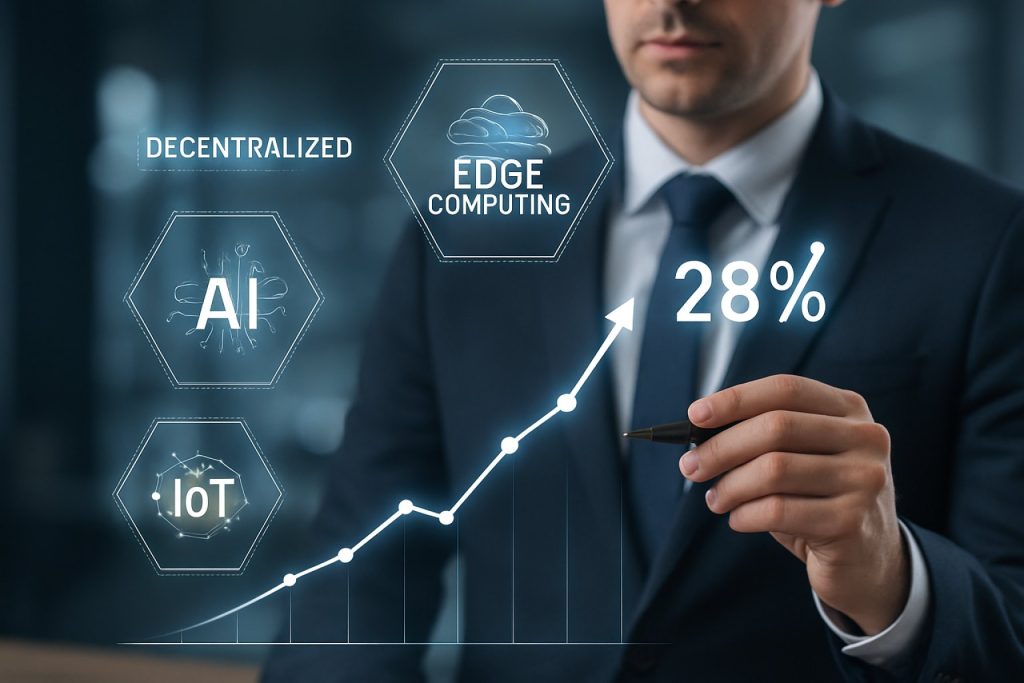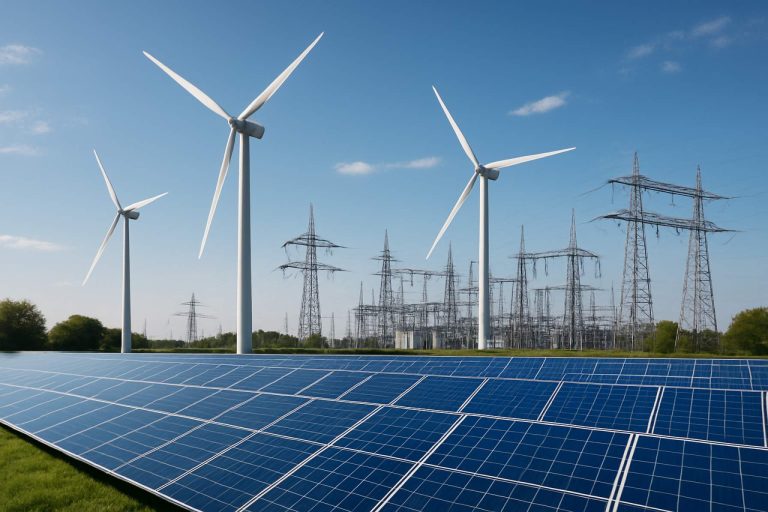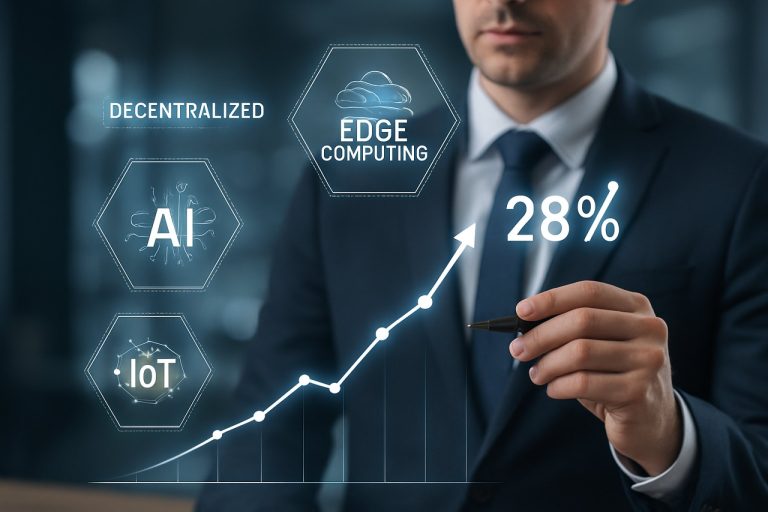
Decentralized Edge Computing Industry Report 2025: Market Dynamics, Technology Innovations, and Strategic Forecasts. Explore Key Growth Drivers, Regional Trends, and Competitive Insights Shaping the Next 5 Years.
- Executive Summary & Market Overview
- Key Technology Trends in Decentralized Edge Computing
- Competitive Landscape and Leading Players
- Market Growth Forecasts (2025–2030): CAGR, Revenue, and Adoption Rates
- Regional Analysis: North America, Europe, Asia-Pacific, and Rest of World
- Future Outlook: Emerging Use Cases and Investment Hotspots
- Challenges, Risks, and Strategic Opportunities
- Sources & References
Executive Summary & Market Overview
Decentralized edge computing is an emerging paradigm that distributes data processing, storage, and application services closer to the data source or end user, leveraging a network of edge devices rather than relying solely on centralized cloud infrastructure. This approach addresses the growing demand for low-latency, high-bandwidth, and privacy-sensitive applications across industries such as manufacturing, healthcare, automotive, and smart cities. By 2025, the decentralized edge computing market is poised for significant expansion, driven by the proliferation of Internet of Things (IoT) devices, advancements in 5G connectivity, and the increasing need for real-time analytics.
According to Gartner, by 2025, 75% of enterprise-generated data will be created and processed outside traditional data centers or cloud environments, underscoring the shift toward edge-centric architectures. The global edge computing market, which includes decentralized solutions, is projected to reach $61.14 billion by 2025, growing at a CAGR of 38.4% from 2020, as reported by MarketsandMarkets. Decentralized edge computing, in particular, is gaining traction due to its ability to enhance data sovereignty, reduce network congestion, and improve application responsiveness.
Key drivers for this market include the exponential growth of connected devices—expected to surpass 30 billion by 2025, according to Statista—and the increasing adoption of AI and machine learning at the edge. Sectors such as autonomous vehicles, remote healthcare monitoring, and industrial automation are leading adopters, as they require instantaneous data processing and decision-making capabilities. Furthermore, decentralized edge computing supports emerging business models, such as distributed marketplaces and peer-to-peer services, by enabling secure, direct interactions between devices.
Despite its promise, the market faces challenges related to interoperability, security, and management of distributed resources. However, ongoing standardization efforts by organizations like the OpenFog Consortium and the LF Edge project are helping to address these issues, fostering a more robust and scalable ecosystem. As enterprises increasingly prioritize agility, data privacy, and operational efficiency, decentralized edge computing is set to become a foundational technology in the digital infrastructure landscape by 2025.
Key Technology Trends in Decentralized Edge Computing
Decentralized edge computing is rapidly transforming the digital infrastructure landscape by distributing data processing closer to the source of data generation, rather than relying solely on centralized cloud servers. This paradigm shift is driven by the need for ultra-low latency, enhanced privacy, and improved bandwidth efficiency, especially as the proliferation of IoT devices and real-time applications accelerates. In 2025, several key technology trends are shaping the evolution and adoption of decentralized edge computing.
- Integration of AI and Machine Learning at the Edge: Edge devices are increasingly equipped with AI and ML capabilities, enabling real-time analytics and decision-making without the need to transmit data to centralized data centers. This trend is supported by advancements in edge-optimized chipsets and frameworks, as highlighted by NVIDIA and Intel, which are developing specialized hardware for edge AI workloads.
- Blockchain-Enabled Edge Networks: Blockchain technology is being leveraged to enhance security, trust, and data integrity in decentralized edge environments. By enabling peer-to-peer transactions and decentralized consensus, blockchain reduces reliance on central authorities and mitigates single points of failure. Companies like IBM and Huawei are actively exploring blockchain integration for edge computing use cases.
- Federated Learning and Privacy-Preserving Computation: Federated learning allows edge devices to collaboratively train machine learning models without sharing raw data, addressing privacy concerns and regulatory requirements. This approach is gaining traction in sectors such as healthcare and finance, as noted by Gartner in its 2024 market analysis.
- 5G and Beyond: The rollout of 5G networks is a catalyst for decentralized edge computing, providing the high bandwidth and low latency necessary for real-time applications. According to Ericsson, 5G adoption is accelerating edge deployments in smart cities, autonomous vehicles, and industrial automation.
- Open Source and Interoperability: The rise of open-source edge platforms, such as LF Edge, is fostering interoperability and reducing vendor lock-in. This trend is crucial for building scalable, heterogeneous edge ecosystems that can support diverse applications and devices.
These technology trends are collectively driving the maturation of decentralized edge computing, positioning it as a foundational element of next-generation digital infrastructure in 2025 and beyond.
Competitive Landscape and Leading Players
The competitive landscape of decentralized edge computing in 2025 is characterized by a dynamic mix of established technology giants, innovative startups, and open-source consortiums, all vying to shape the future of distributed data processing. As enterprises and service providers increasingly seek to minimize latency, enhance data privacy, and reduce bandwidth costs, the market has seen a surge in both investment and partnership activity.
Leading players in this space include IBM, Microsoft, and Hewlett Packard Enterprise (HPE), each leveraging their cloud and edge portfolios to offer hybrid solutions that integrate decentralized edge nodes with centralized cloud management. IBM has expanded its Edge Application Manager to support decentralized orchestration, while Microsoft Azure IoT Edge continues to add features for secure, distributed AI inference at the edge.
Emerging startups such as Edgeworx and FogHorn are gaining traction with lightweight, containerized edge platforms that enable real-time analytics and decentralized decision-making. These companies focus on interoperability and open standards, often collaborating with industry alliances like the LF Edge project, which fosters open-source edge frameworks and reference architectures.
Telecommunications providers, including Verizon and AT&T, are also key players, leveraging their 5G infrastructure to deploy decentralized edge nodes closer to end users. Their partnerships with cloud providers and edge software vendors are accelerating the rollout of edge-enabled services for sectors such as autonomous vehicles, smart cities, and industrial IoT.
- Gartner projects that by 2025, 30% of enterprise infrastructure will be deployed at the edge, up from 10% in 2023.
- IDC notes that the decentralized edge market is highly fragmented, with over 100 vendors offering specialized solutions for different verticals and use cases.
As the market matures, competition is intensifying around interoperability, security, and the ability to manage large-scale, heterogeneous edge environments. Strategic alliances, open-source initiatives, and vertical-specific solutions are expected to further shape the competitive dynamics through 2025 and beyond.
Market Growth Forecasts (2025–2030): CAGR, Revenue, and Adoption Rates
The decentralized edge computing market is poised for robust expansion between 2025 and 2030, driven by the proliferation of IoT devices, increasing demand for low-latency data processing, and the growing adoption of decentralized architectures across industries. According to projections by Gartner, the global edge computing market is expected to reach $317 billion by 2025, with decentralized solutions accounting for a significant and growing share as enterprises seek to reduce reliance on centralized cloud infrastructure.
Market analysts at International Data Corporation (IDC) forecast a compound annual growth rate (CAGR) of approximately 24% for decentralized edge computing platforms from 2025 to 2030. This growth is underpinned by the increasing deployment of edge nodes in sectors such as manufacturing, healthcare, smart cities, and autonomous vehicles, where real-time data processing and privacy are critical. By 2030, the decentralized edge computing segment is projected to generate annual revenues exceeding $120 billion, up from an estimated $40 billion in 2025.
Adoption rates are expected to accelerate as organizations recognize the benefits of decentralized edge architectures, including enhanced data sovereignty, improved security, and reduced network congestion. A 2024 survey by Accenture found that 62% of enterprises plan to increase investments in decentralized edge solutions by 2025, with over 40% of new edge deployments expected to leverage decentralized frameworks rather than traditional centralized models.
- Revenue Growth: Annual revenues from decentralized edge computing are forecast to triple between 2025 and 2030, reflecting both increased adoption and expanding use cases.
- CAGR: The segment is expected to maintain a CAGR of 24% over the forecast period, outpacing the broader edge computing market.
- Adoption Rates: By 2030, it is anticipated that more than 55% of all edge computing deployments will utilize decentralized architectures, up from less than 30% in 2025.
These forecasts underscore the transformative potential of decentralized edge computing, as enterprises and service providers seek to harness its advantages for scalability, resilience, and real-time intelligence at the network’s edge.
Regional Analysis: North America, Europe, Asia-Pacific, and Rest of World
The decentralized edge computing market is experiencing varied growth trajectories across North America, Europe, Asia-Pacific, and the Rest of the World, shaped by regional technological maturity, regulatory environments, and industry adoption rates.
- North America: North America remains at the forefront of decentralized edge computing adoption, driven by robust investments in 5G, IoT, and AI infrastructure. The United States, in particular, benefits from a strong ecosystem of cloud providers, hyperscalers, and edge startups. Key sectors such as autonomous vehicles, smart manufacturing, and healthcare are accelerating demand for low-latency, decentralized solutions. According to International Data Corporation (IDC), North America accounted for over 35% of global edge spending in 2024, a trend expected to continue into 2025 as enterprises prioritize data sovereignty and real-time analytics.
- Europe: Europe’s decentralized edge computing market is shaped by stringent data privacy regulations, such as GDPR, and a strong push for digital sovereignty. Countries like Germany, France, and the UK are investing in edge infrastructure to support smart cities, energy management, and industrial automation. The European Union’s initiatives to foster cross-border data flows and edge innovation are expected to drive steady market growth. Gartner projects that Europe will see a compound annual growth rate (CAGR) of over 18% in edge deployments through 2025, with a focus on secure, interoperable solutions.
- Asia-Pacific: The Asia-Pacific region is witnessing the fastest growth in decentralized edge computing, fueled by rapid urbanization, expanding 5G networks, and government-led digital transformation programs. China, Japan, and South Korea are leading the charge, leveraging edge computing for smart transportation, industrial IoT, and consumer applications. Frost & Sullivan notes that Asia-Pacific’s edge market is expected to outpace other regions, with a projected CAGR exceeding 22% through 2025, as enterprises seek to localize data processing and reduce network congestion.
- Rest of World: In regions such as Latin America, the Middle East, and Africa, decentralized edge computing adoption is emerging but remains constrained by infrastructure gaps and limited investment. However, targeted initiatives in sectors like agriculture, mining, and telecommunications are beginning to drive pilot projects. According to Statista, these regions are expected to gradually increase their share of global edge spending, particularly as connectivity improves and cloud providers expand their regional presence.
Future Outlook: Emerging Use Cases and Investment Hotspots
Decentralized edge computing is poised for significant evolution in 2025, driven by the convergence of 5G, AI, and blockchain technologies. As enterprises and service providers seek to overcome the limitations of centralized cloud models—such as latency, bandwidth constraints, and data sovereignty—decentralized edge architectures are emerging as a critical enabler for next-generation digital services.
Emerging Use Cases
- Autonomous Systems: The proliferation of autonomous vehicles, drones, and robotics is accelerating demand for real-time data processing at the edge. Decentralized edge nodes enable ultra-low latency decision-making, which is essential for safety and operational efficiency. In 2025, pilot projects in smart transportation and logistics are expected to scale, leveraging decentralized edge for vehicle-to-everything (V2X) communications and fleet management (Gartner).
- Industrial IoT (IIoT): Manufacturing and energy sectors are deploying decentralized edge solutions to support predictive maintenance, quality control, and real-time analytics. By processing data locally, organizations can reduce downtime and enhance operational resilience, especially in remote or hazardous environments (IDC).
- Decentralized AI and Federated Learning: Edge nodes are increasingly used to train and deploy AI models without centralizing sensitive data. This approach supports privacy regulations and enables collaborative intelligence across distributed devices, with applications in healthcare diagnostics, smart cities, and personalized retail (Accenture).
- Blockchain-Enabled Edge Marketplaces: Blockchain integration is facilitating secure, peer-to-peer resource sharing and microtransactions at the edge. Decentralized marketplaces for compute, storage, and data exchange are emerging, allowing enterprises and individuals to monetize idle resources and foster new business models (Dell Technologies).
Investment Hotspots
- Asia-Pacific: Rapid urbanization and 5G rollouts in China, South Korea, and Japan are catalyzing edge infrastructure investments, particularly for smart city and industrial automation projects (Mordor Intelligence).
- North America: The U.S. is leading in venture funding for edge startups, with a focus on cybersecurity, AI at the edge, and decentralized data platforms (CB Insights).
- Europe: The EU’s emphasis on data sovereignty and digital infrastructure is driving public-private partnerships in decentralized edge deployments, especially in healthcare and energy sectors (European Commission).
In 2025, the decentralized edge computing landscape will be shaped by these emerging use cases and regional investment trends, setting the stage for broader adoption and innovation across industries.
Challenges, Risks, and Strategic Opportunities
Decentralized edge computing is poised to transform data processing by distributing computational resources closer to data sources, but the path to widespread adoption in 2025 is marked by significant challenges, risks, and strategic opportunities.
Challenges and Risks
- Interoperability and Standardization: The lack of unified standards for decentralized edge architectures complicates integration across diverse hardware, software, and network environments. This fragmentation can hinder scalability and slow ecosystem development, as highlighted by ETSI and OpenFog Consortium initiatives.
- Security and Privacy: Distributing data and computation across numerous edge nodes increases the attack surface. Ensuring end-to-end security, robust authentication, and data privacy is complex, especially as edge devices often have limited resources for advanced security protocols. Gartner notes that edge deployments are particularly vulnerable to physical tampering and cyberattacks.
- Resource Management: Decentralized edge environments require dynamic orchestration of compute, storage, and network resources. Managing these resources efficiently, especially in heterogeneous and mobile settings, remains a technical hurdle, as reported by IDC.
- Regulatory Compliance: Data sovereignty and compliance with regional regulations (such as GDPR) are more complex in decentralized architectures, where data may traverse multiple jurisdictions, according to Accenture.
Strategic Opportunities
- Industry-Specific Solutions: Sectors like manufacturing, healthcare, and autonomous vehicles can leverage decentralized edge computing for ultra-low latency, real-time analytics, and improved reliability. IBM and Hewlett Packard Enterprise are investing in tailored edge platforms for these verticals.
- AI and Machine Learning at the Edge: Deploying AI models directly on edge devices enables faster decision-making and reduces bandwidth costs. NVIDIA and Qualcomm are advancing edge AI chipsets and frameworks.
- Decentralized Data Marketplaces: The rise of blockchain-enabled edge networks opens new business models for secure, peer-to-peer data exchange, as explored by IOTA Foundation.
- Resilience and Redundancy: Decentralized architectures can enhance system resilience by reducing single points of failure, a key advantage for critical infrastructure and remote operations, as noted by Microsoft.
In 2025, organizations that proactively address these challenges and capitalize on emerging opportunities will be best positioned to unlock the full value of decentralized edge computing.
Sources & References
- MarketsandMarkets
- Statista
- OpenFog Consortium
- LF Edge
- NVIDIA
- IBM
- Huawei
- Microsoft
- Verizon
- IDC
- Accenture
- Frost & Sullivan
- Dell Technologies
- Mordor Intelligence
- European Commission
- Qualcomm
- IOTA Foundation



